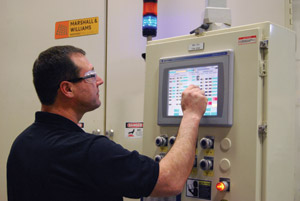by Brian Lundgren & Ken Forziati

In the first installment of this article, we reviewed how the material cost savings realized by running trials on a pilot scale line vs. production line can more than offset the expense of using an external facility like our Biax Lab. Beyond that, however, conducting trials on a dedicated external pilot line can provide additional advantages that improve the chances of successfully running an R&D project to completion.
The first and perhaps best reason for running development trials on a dedicated external pilot line is that it will likely be staffed by professional technicians who run these kinds of trials day in and day out. The skillsets and mindsets of production line operators are quite different from those of pilot lab technicians. Production personnel are normally focused on optimizing the throughput and quality of a limited number of formulations. They make small adjustments in processing conditions to achieve these goals.
When running trials, however, the goals are usually quite different. One typical goal is to define a process window for new materials, where key process conditions like temperatures or stretching conditions (draw ratio, stretch rate, etc.) will be varied from one bound of process-ability to another, collecting numerous samples and documenting process conditions for each along the way. Another goal is to vary the concentration or composition of one or more ingredients, over a specified range. In this case, each formulation must be accurately fed into the system, process conditions may need to be adjusted significantly and recorded, and samples will need to be collected. In either of these trial scenarios, throughput and fine tuning of quality are usually not a priority, as small quantities of samples of sufficient quality for properties testing are usually the desired outcome.
Our pilot line technicians do this on a daily basis and are accustomed to stretching the limits of the equipment in the process to achieve customers’ goals, which is their primary concern. Production staff, on the other hand, often are hesitant to “mess with the settings” for fear that they will not be able to “dial in” their next production run, and helping the researcher achieve his/her goals is not their highest priority.
One other benefit to working with experienced pilot line technicians is that by working side-by-side with them, researchers can gain significant insight into the process. Because they have run a wide range of materials for many applications, they will have insight that any production operator would never have an opportunity to learn in a typical manufacturing environment. This process knowledge also helps pilot line operators to run trials more efficiently, by quickly focusing on the critical process parameters to achieve a desired outcome. They are therefore able to run trials much more efficiently providing greater value in the time and effort spent running trials.
In addition to benefiting from working with experienced technicians, an OEM pilot line will likely provide much greater process flexibility with a wider range of capabilities than would a production line, which is optimized to manufacture a limited number of products highly efficiently.
For example, a commercial biaxial orientation line, will be designed for a specified base material (e.g. PP, PET, PETG, or PS) design throughput, line speed, finished thickness, and end application (e.g. heat stable packaging/specialty film, OPS sheet for thermoforming, microporous membrane for battery separator, shrink label film, etc.) Attempting to run trials on a different material and/or different application on a production line for which it was not designed would be much less likely to succeed. A versatile pilot line, however, should have the flexibility to vary setup configurations (dies, feedblocks, and auxiliary equipment such as blenders, feeders, dryers) to handle a broad range of materials and layer structures, as well as run a wide range of process conditions such as temperature, stretch ratios, stretch rates, and line speeds. While it will not be as efficient at cranking out a handful of large volume, high-quality products, it will certainly be more efficient at conducting trials over a wide range of applications and process conditions, with good correlation to scalability for eventual production.
A unique benefit to working with an OEM is that we also have the ability in-house to provide custom-built equipment to lab customers, allowing us to adapt and modify our pilot line as required to respond to their specific R&D needs, and to explore novel processes.